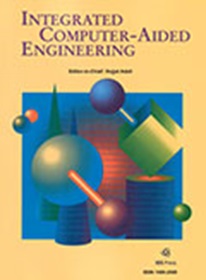基于参数和特征的 CAD 数据集,支持先进 3D 形状学习的人机交互
IF 5.3
2区 计算机科学
Q1 COMPUTER SCIENCE, ARTIFICIAL INTELLIGENCE
引用次数: 0
摘要
三维形状学习是计算机视觉领域的一个重要研究课题,其中数据集起着至关重要的作用。然而,现有的三维数据集大多使用体素、点云、网格和 B-rep,它们不是基于参数和特征的。因此,它们无法支持生成具有复杂形状特征的真实工程计算机辅助设计(CAD)模型。此外,它们基于三维几何结果,没有人机交互(HCI)历史。这项研究首次提供了一个完整的基于参数和特征的 CAD 数据集,该数据集具有支持三维学习中人机交互的选择机制。首先,与现有数据集主要由简单特征(典型草图和挤出)组成不同,我们设计了复杂的工程特征,如圆角、倒角、镜面、口袋、凹槽和旋转。其次,与单调的特征组合不同,我们发明了一种选择机制,模仿人类关注和选择特定拓扑实体的方式。所提出的机制建立了复杂工程特征之间的关系,充分表达了人类 CAD 工程师的设计意图和设计知识。因此,它可以处理真实世界工程形状的高级三维特征。实验表明,所提出的数据集在重建和生成任务方面都优于现有的 CAD 数据集。在定量实验中,建议的数据集比其他参数数据集具有更高的预测精度。此外,从提出的数据集生成的 CAD 模型符合人类 CAD 工程师的语义,并可通过主流工业 CAD 软件进行编辑和重新设计。本文章由计算机程序翻译,如有差异,请以英文原文为准。
A parametric and feature-based CAD dataset to support human-computer interaction for advanced 3D shape learning
3D shape learning is an important research topic in computer vision, in which the datasets play a critical role. However, most of the existing 3D datasets use voxels, point clouds, mesh, and B-rep, which are not parametric and feature-based. Thus they can not support the generation of real-world engineering computer-aided design (CAD) models with complicated shape features. Furthermore, they are based on 3D geometry results without human-computer interaction (HCI) history. This work is the first to provide a full parametric and feature-based CAD dataset with a selection mechanism to support HCI in 3D learning. First, unlike existing datasets, mainly composed of simple features (typical sketch and extrude), we devise complicated engineering features, such as fillet, chamfer, mirror, pocket, groove, and revolve. Second, different from the monotonous combination of features, we invent a select mechanism to mimic how human focuses on and selects a particular topological entity. The proposed mechanism establishes the relationships among complicated engineering features, which fully express the design intention and design knowledge of human CAD engineers. Therefore, it can process advanced 3D features for real-world engineering shapes. The experiments show that the proposed dataset outperforms existing CAD datasets in both reconstruction and generation tasks. In quantitative experiment, the proposed dataset demonstrates better prediction accuracy than other parametric datasets. Furthermore, CAD models generated from the proposed dataset comply with semantics of the human CAD engineers and can be edited and redesigned via mainstream industrial CAD software.
求助全文
通过发布文献求助,成功后即可免费获取论文全文。
去求助
来源期刊

Integrated Computer-Aided Engineering
工程技术-工程:综合
CiteScore
9.90
自引率
21.50%
发文量
21
审稿时长
>12 weeks
期刊介绍:
Integrated Computer-Aided Engineering (ICAE) was founded in 1993. "Based on the premise that interdisciplinary thinking and synergistic collaboration of disciplines can solve complex problems, open new frontiers, and lead to true innovations and breakthroughs, the cornerstone of industrial competitiveness and advancement of the society" as noted in the inaugural issue of the journal.
The focus of ICAE is the integration of leading edge and emerging computer and information technologies for innovative solution of engineering problems. The journal fosters interdisciplinary research and presents a unique forum for innovative computer-aided engineering. It also publishes novel industrial applications of CAE, thus helping to bring new computational paradigms from research labs and classrooms to reality. Areas covered by the journal include (but are not limited to) artificial intelligence, advanced signal processing, biologically inspired computing, cognitive modeling, concurrent engineering, database management, distributed computing, evolutionary computing, fuzzy logic, genetic algorithms, geometric modeling, intelligent and adaptive systems, internet-based technologies, knowledge discovery and engineering, machine learning, mechatronics, mobile computing, multimedia technologies, networking, neural network computing, object-oriented systems, optimization and search, parallel processing, robotics virtual reality, and visualization techniques.
 求助内容:
求助内容: 应助结果提醒方式:
应助结果提醒方式:


